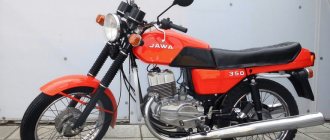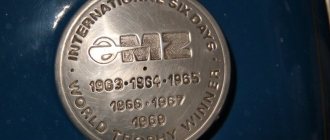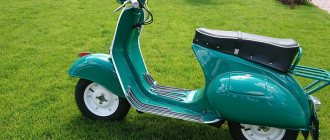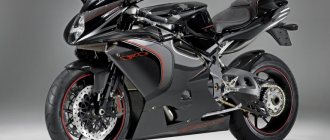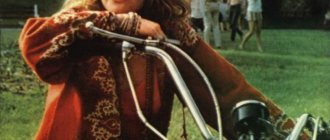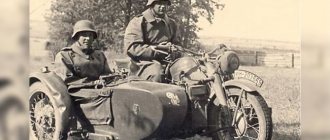The first years of the USSR
The first attempts to restore work, which was actually the pioneer of the motorcycle industry before the revolution, were not made soon. In 1918, the enterprise was renamed “State Aviation Plant No. 1” and focused on the production of aircraft parts, railcars and other products.
The plant tried to return to its usual course in 1924, when a group of engineers developed and built on it the very first Soviet motorcycle, which received the symbolic name “Soyuz”. In comparison with the models produced in 1910-14, this was a confident step forward. Firstly, the car was built on the basis of a single-cylinder 4-stroke 503 “cc” engine and even had a soft suspension on both wheels, a multi-plate clutch and a three-speed gearbox. And, secondly, unlike its predecessors, it consisted almost entirely of domestic parts. The only exceptions were the magneto and carburetor, but even the engine was designed and manufactured in the Soviet Union.
In general, the development turned out to be successful and even quite successfully participated in the “Second Test Automobile Rally”, which took place in 1925, but for some reason it never went into mass production.
Dnepr 11
And this model of Soviet motorcycles, although universal in design and operation, was in greatest demand among “rockers.” The first Soviet bikers considered the Dnepr 11 one of the best; the motorcycle was produced in Kyiv.
The design of the motorcycle is simple and easy to repair; most also tried to tune the model, which was quite possible with little effort. An interesting fact is that Soviet Dnepr 11 motorcycles can still be found on the roads in working condition.
First production models
The next attempt to put the abandoned industry back on its feet came at the very beginning of the 1930s and was much more successful: several factories located in Leningrad, Izhevsk, Podolsk and Taganrog began working on the development of the direction, and the first available production models entered the market.
The pioneer among them was the L-300 motorcycle, also later called the “Red October” in honor of the Leningrad plant where it continued to be assembled. Since the domestic motorcycle industry was just beginning to develop, the first production model was based on the successful developments of foreign colleagues, specifically the German motorcycle DKW Luxus 300.
For its time, this model, and, accordingly, the Soviet analogue, were very progressive, albeit not very powerful. They were based on a single-cylinder 2-stroke engine with a volume of 293 cm3, and the design included a three-speed gearbox, front spring suspension and a headlight.
The first copies rolled off the assembly lines already in 1930, and in 1931 three L-300s took part in a kind of test cross-country rally race for 4631 km, with 2/3 of the route being off-road. The motorcycles showed their best performance, so they soon went on sale not only, but also began to be produced for the army. Moreover, this particular model can be called the first Soviet sports motorcycle, since it actively participated in various competitions.
With a slight delay, starting in 1933, Izhevsk established mass production of its own models. It is very interesting that he prepared prototypes much more actively than his “competitor” and even produced as many as 5 different models (IZH 1-5) back in 1928-29, but came to full-fledged serial production later. Moreover, the first mass-produced Izhevsk model, called “IZH-7,” was actually a “copy of a copy.” It was still the same L-300, but even cheaper: the model did not have a trunk, a rotating throttle handle or a remote decompressor. The reduction in price affected not only convenience and overall quality. Even its release turned out to be a false start: all 12 of the first motorcycles were returned to the factory due to ignition problems. Subsequently, IZH-7 and L-300 were produced in parallel.
Specifications
In the technical passport, the single-barreled hunting rifle is described as an external trigger gun. Performance characteristics of IZH-5 look like this:
- The length of the barrel can vary between 680-760 mm, however, there is unconfirmed evidence of the presence of a barrel of 800 mm.
- The longer the barrel, the greater the weight of the weapon and is in the range of 2.5-3 kg.
- Caliber 16-28.
- Accuracy 4%.
- Cartridges with a paper sleeve are used.
- To fire a shot you need to apply a force of 3 kg.
Accuracy, although stated at 40%, when tested with a load of No. 3 shot and black powder, often approached 47%
For the cylindrical drill barrel of the 16-gauge hammer, “50a” steel was used. At the end there was a pressure - a muzzle constriction. The nominal value of the caliber did not always correspond to the actual value, so many hunters, without relying on the specified parameters, took measurements themselves.
Years before the war
In 1938, the “seven” was replaced by a new modification – “IZH-8”. It received a significantly more powerful engine (8 hp) and a modern ignition system - instead of the usual magneto of that time, it used a pair of battery and generator that later became standard. Just 2 years later, production of the new model “IZH-9” began, with an even more powerful (9 hp) engine.
However, active work was carried out not only by “Red October” and “IZHMASH”, which produced light motorcycles “for the people”. So in 1934, the Podolsk Mechanical Plant began producing the first heavy motorcycle, the PMZ-A-750, primarily intended for the army. By design, it was also a partial “clone” of foreign technology, not just one, but several models at once. For example, Soviet designers spied the frame from BMW, and as an engine they offered their version of the American V-shaped 750 “cc” engine installed in Harley-Davidson motorcycles.
Despite extremely advanced technical solutions (for example, an ignition switch that could not be found in any other Soviet model), the PMZ-A-750 turned out to be extremely capricious and not very reliable in operation, so in 1939 it was withdrawn from service army and from production. Since then, PMZ no longer produced motorcycles, and the place of the military iron horse was taken by the M-72 model, which became another “analogue” of European technology, this time the BMW R71. By the way, it was she who became the main motorcycle of the Soviet troops during the Second World War.
Another attempt to create a reliable heavy motorcycle was made in 1935 at TIZ - Taganrog Tool Plant. Its designers did not reinvent the wheel and simply copied the successful English model BSA Sloper with a 600 cc engine, giving their version the simple and understandable name TIZ AM-600. The resulting vehicle was considered one of the most reliable, so a special modification was even produced for the needs of the NKVD, equipped with a machine gun turret instead of a sidecar. With the outbreak of the war, production was moved from Taganrog to Tyumen, where the TIZ AM-600, previously slightly modified, continued to be produced until 1943.
"Izh Planet"
1962 The Izhevsk Motorcycle Plant is starting to assemble a fundamentally new model for itself, “Izh Planet”, which became the ancestor of a whole family that was produced until 2008 (“Izh Planet 7”).
A middle-class motorcycle created on the basis of the Izh-56 was intended for driving on roads with different surfaces. The warranty mileage of the Izh Planeta has increased by 2,000 km compared to its predecessor, and the service life of the cylinder-piston group parts has increased by one and a half times (thanks to the use of a contact-oil air cleaner).
A new gas tank, easily removable seat, and mufflers were installed. Instead of stamped front and rear wings, stamped-welded ones were used.
The Izh Planet was powered by a single-cylinder, two-stroke air-cooled engine. The crankshaft is prefabricated and pressed. Carter is of block type. The crank chamber is located in the front part, and the gearbox is located in the rear part. The crankcase consists of two halves with a connector along the middle longitudinal plane. The foot shift and kickstart pedals are located on the left side of the gearbox housing.
The motorcycle was produced until 1966, a total of 405,303 copies were produced - a fairly decent circulation for those times.
Variety of post-war models
Like the revolution of 1917, World War II dealt a serious blow to the Soviet motorcycle industry. Motorcycles continued to be produced and actively used by the army, but there was absolutely no talk of developing new models. This situation continued for several post-war years: while the country was rising from its knees, the economy used exclusively motorcycles that had survived the war.
The industry began to recover only in the early 1950s, and this process was quite painful. For the most part, motorcycle models new to the USSR were, to a greater or lesser extent, copies of German motorcycles and were produced according to drawings inherited from Germany defeated in the war.
At the same time, the list of factories producing motorcycles has grown quite significantly. So, in addition to the previously operating Izhevsk, factories in Tula, Kovrov, Vyatskie Polyany, Minsk and Riga began to produce motorcycles (including light scooters). All this led to a fairly confident development of the motorcycle industry and a rapid replenishment of the range of models. And if earlier they could literally be counted on one’s fingers, then in the period of the 50s and, especially, the 60-70s, the total number of different modifications amounted to dozens. The most interesting and significant among them were:
- M1A "Moscow" (aka "Minsk M1A") - the first light motorcycle of the post-war years. A copy of the German DKW RT125 with a 125 cm3 engine. By the beginning of the 50s, it was produced at several factories at once, including the Kovrov ZiD under the designation K-125. It was the main training machine in DOSAAF schools.
- IZH-49 is a copy of the DKW NZ 350. A fairly versatile motorcycle that could be equipped with a sidecar, and later even became the basis for the production of sports cross-country and road models.
- “Sunrise” is the founder of the series of the same name, released in 1957. A lightweight, unpretentious motorcycle with a single-cylinder 174 cm3 engine, which has gained enormous popularity among the population.
- “Ural M-62” is a heavy motorcycle with a 4-stroke 28 hp engine, produced by the Irbit Motorcycle Plant since 1961. Mainly used by the police, but complete with a stroller it was also used by citizens.
- “IZH Planet” is a road motorcycle with a single-cylinder 2-stroke engine with a power of 13 hp, the production of which was launched in 1962. Quite a successful and popular model, which became the ancestor of not only the entire “Planets” series, but also the ancestor of the sports “IZH Planet Sport”.
How are Soviet bikes used now?
Nowadays, retro motorcycles of the USSR can be seen both in museums and on public roads. They have hardly lost their popularity and are still used in agriculture, and young people get their first driving experience . Of course, the harsh conditions of use of those times do not allow finding a unit in excellent condition, and the technical part of Russian production has always left much to be desired. However, Soviet motorcycles are still running and even look quite tolerable.
In general, USSR motorcycles are in no way inferior, and in many ways even superior to foreign manufacturers. Not every foreign car can boast cross-country capability of the Dnieper or the Urals. Moreover, motorcycle spare parts are always easy to find and repair yourself.
For many people, Soviet units will always be more in demand than others. After all, we not only worked and went on vacation with them, but also won wars. Nowadays there are many collectors who collect the rarest motorcycle models. By restoring them, they achieve maximum proximity to the original. You've probably seen a very old bike with an excellent appearance more than once. A trip on such a unit across Russia evokes among insiders not only admiration for the device, but also respect for its owner.
